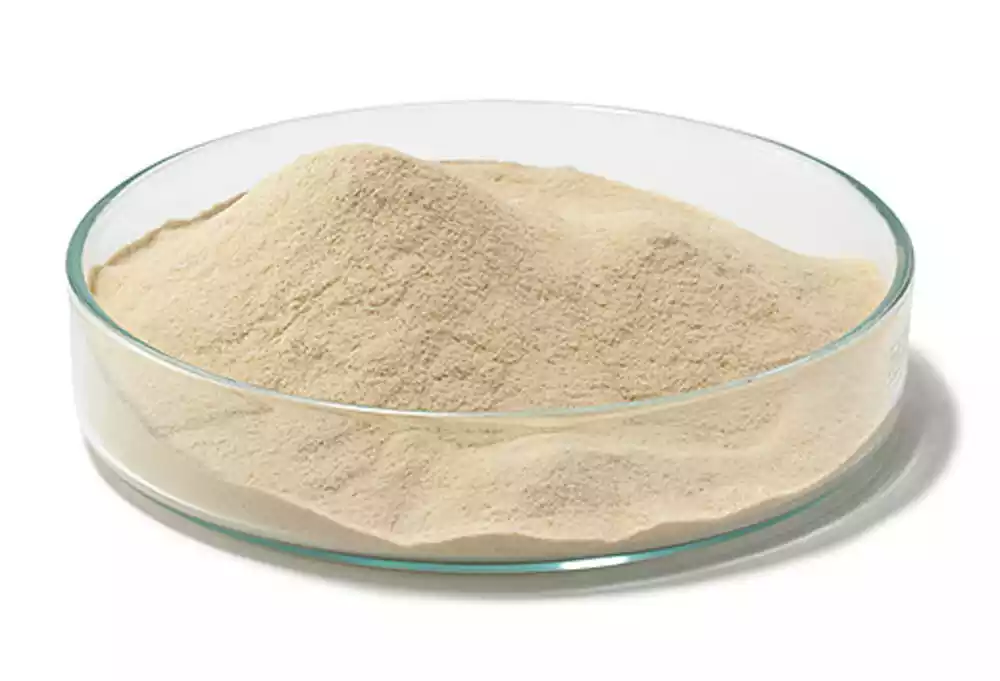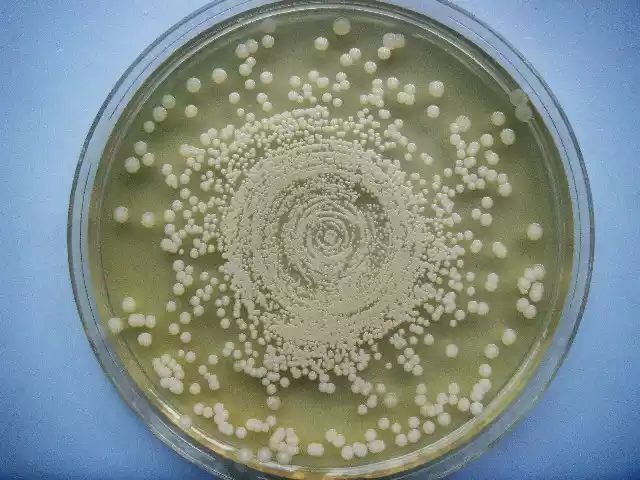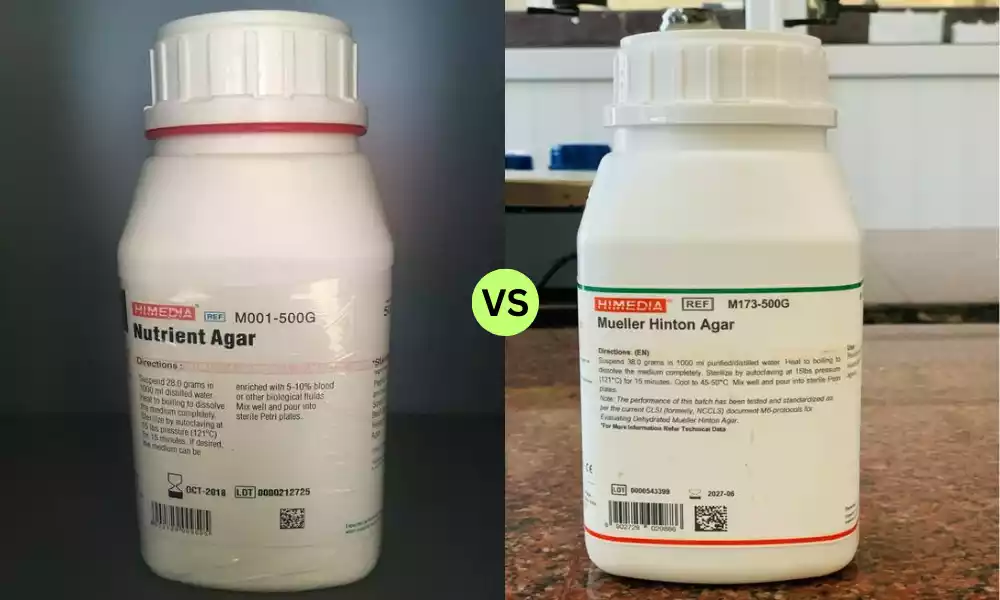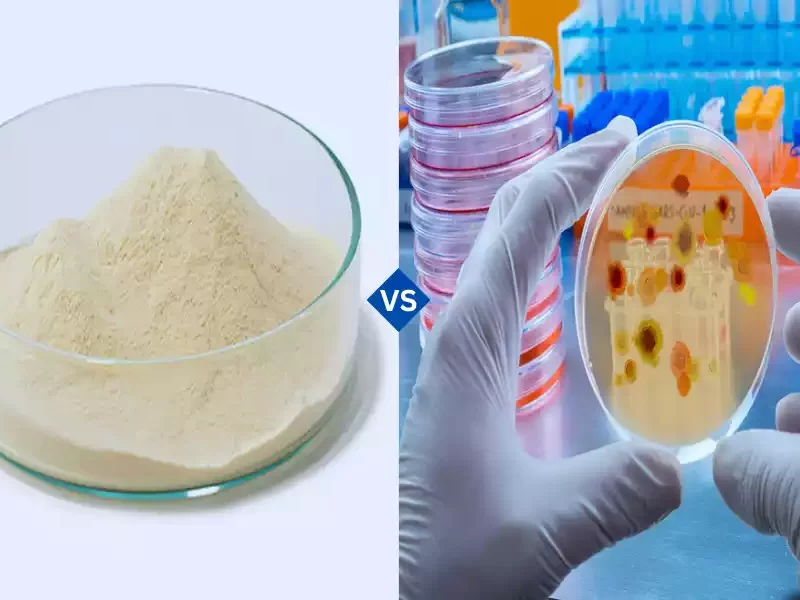Nutrient Agar and Mueller Hinton Agar are fundamental media in microbiology, each with its distinct application. NA, a general-purpose medium, facilitates the growth of a vast array of non-fastidious bacteria, making it invaluable for basic microbiological studies. In contrast, MHA, with its specialized composition, is pivotal for antibiotic susceptibility testing, directly influencing therapeutic decisions in clinical settings. While both media support bacterial cultivation, their primary uses and significance diverge. Together, they underscore the breadth and depth of microbiological tools, catering to both foundational research and critical clinical outcomes.
What is Nutrient Agar?
Nutrient Agar is a solid growth medium, commonly used in microbiology laboratories to cultivate a wide variety of microorganisms. It provides a simple environment suitable for the growth of bacteria that are not too finicky about their nutritional needs.

Composition
The primary components of Nutrient Agar are:
- Peptone: Derived from animal protein, peptone provides a source of nitrogen in the form of amino acids. This promotes the growth of bacteria by supplying them with essential nutrients.
- Beef Extract: This is a concentrated water-soluble extract from boiled beef. Beef extract offers additional vitamins, salts, and certain carbon sources required by microorganisms.
- Agar: Extracted from certain marine algae, agar acts as a solidifying agent. When heated and then cooled, it forms a gel-like consistency, making the medium firm enough to support bacterial growth on its surface.
Uses and Applications
Nutrient Agar serves various functions in microbiology:
- Culture Maintenance: It provides a habitat for growing and maintaining bacterial cultures for prolonged periods.
- Bacterial Identification: By cultivating bacteria on Nutrient Agar plates, scientists can observe the morphology of bacterial colonies, aiding in their identification.
- Antibiotic Sensitivity: While not its primary use, Nutrient Agar can be employed for some preliminary antibiotic sensitivity tests.
- Water Analysis: It’s also used to determine the microbial count present in water, helping in assessing water purity.
Advantages
The simplicity of Nutrient Agar is its strength:
- Versatility: Suitable for many bacterial types due to its non-specific nutrient composition.
- Accessibility: Its ingredients are readily available, making it a cost-effective choice for many laboratories.
- Ease of Use: Being a general-purpose medium, it doesn’t require specialized preparation methods.
Limitations
While Nutrient Agar is versatile, it does have limitations:
- Non-Selective: It doesn’t inhibit the growth of unwanted microorganisms. If you’re trying to isolate a specific bacterium from a mixed sample, other specialized media might be more appropriate.
- Lack of Differentiation: Unlike differential media, which change color or appearance based on the metabolic activities of microbes, Nutrient Agar doesn’t provide such visual cues.
Nutrient Agar remains a staple in microbiology for its broad application and simplicity. Whether you’re a student learning basic microbial techniques or a seasoned scientist conducting experiments, this medium is likely a familiar tool in your repertoire.
What is Mueller Hinton Agar?
Mueller Hinton Agar, often abbreviated as MHA, is a microbiological growth medium that is widely used for antibiotic susceptibility testing, specifically the Kirby-Bauer disc diffusion method. This medium has found significant application in clinical settings, especially in guiding the treatment of bacterial infections.

Composition
The main components of Mueller Hinton Agar include:
- Beef Infusion: Derived from roasted beef heart, this infusion serves as the foundational base, supplying primary nutrients.
- Casein Hydrolysate: This is a source of amino acids resulting from the enzymatic digestion of casein, a protein found in milk.
- Starch: Starch acts as both an energy source for microorganisms and an agent to absorb any toxic factors present.
- Agar: Just like in Nutrient Agar, agar here serves as the solidifying agent.
Discovery and Development
MHA was originally developed by John Howard Mueller and Jane Hinton in the 1940s. Initially, it was designed to isolate and cultivate pathogenic Neisseria species. Due to its consistent performance, especially in terms of antibiotic diffusion, it became the medium of choice for susceptibility testing.
Importance in Antibiotic Testing
Several factors contribute to the widespread use of MHA in antibiotic testing:
- Consistency: MHA offers a standardized formulation, ensuring consistent results across different labs.
- Reproducibility: The medium allows for consistent antibiotic diffusion, making susceptibility readings more reliable.
- Quality Control: Due to its reputation and widespread use, quality control strains often have well-established growth parameters on MHA, aiding in lab verifications.
Practical Implications
- Thickness Standardization: For susceptibility tests, it’s imperative that MHA plates are poured to a standard depth, usually around 4mm, to ensure uniform diffusion of antibiotics.
- pH Level: The pH of MHA is crucial. A slightly alkaline pH (typically around 7.3 ± 0.1) is ideal for most antibiotic susceptibility tests.
- Avoiding Divalent Cations: High concentrations of magnesium and calcium can interfere with the activity of certain antibiotics, making MHA, which is low in these cations, ideal.
Limitations
While MHA is popular for antibiotic susceptibility testing, it has limitations:
- Not Universal: Some bacteria, especially fastidious ones, may not grow well on MHA, requiring supplements or alternative media.
- Variable Starch Content: The starch in MHA can vary between manufacturers, potentially affecting the diffusion of some antibiotics.
Mueller Hinton Agar remains an essential tool in the realm of clinical microbiology. Its role in guiding antibiotic treatments—helping clinicians decide the best course of action against bacterial pathogens—is invaluable. As antibiotic resistance continues to be a global health concern, reliable tools like MHA become even more crucial in the fight against infectious diseases.
Comparison table of Nutrient Agar and Mueller Hinton Agar
Here’s a comparison table highlighting the differences between Nutrient Agar and Mueller Hinton Agar:
| Feature | Nutrient Agar | Mueller Hinton Agar |
|---|---|---|
| Primary Use | General microbial growth | Antibiotic susceptibility testing |
| Main Components | Peptone, Beef Extract, Agar | Beef Infusion, Casein Hydrolysate, Starch, Agar |
| Derived From | Animal protein and boiled beef | Roasted beef heart and milk protein |
| pH Level | Typically around 6.8 ± 0.2 | Typically around 7.3 ± 0.1 |
| Solidifying Agent | Agar | Agar |
| Consistency When Poured | Variable thickness | Standardized to 4mm thickness |
| Antibiotic Testing Suitability | Limited (not primary use) | Primary medium for antibiotic testing |
| Growth Preference | Supports a wide range of non-fastidious bacteria | Best for non-fastidious bacteria used in testing |
| Divalent Cations Content | Not standardized | Low (to not interfere with antibiotic activity) |
| Typical Applications | Cultivation, bacterial identification, general experiments | Antibiotic disk diffusion tests |
This table provides an overview of the fundamental differences between the two media, but it’s important to understand the underlying reasons for their specific applications, as discussed in previous sections.
What are the similarities between Nutrient Agar and Mueller Hinton Agar?
Both Nutrient Agar (NA) and Mueller Hinton Agar (MHA) are fundamental tools in microbiology, and while they serve different primary purposes, they do share several similarities. Here are the main points of convergence between the two:
- Solidifying Agent: Both NA and MHA use agar as their solidifying agent. Extracted from marine algae, agar provides a gel-like consistency when cooled, allowing the medium to support bacterial growth on its surface.
- Purpose: Both media are designed for the cultivation of bacteria. While their primary applications might differ, they both support bacterial growth and allow for the observation of bacterial colonies.
- Base Ingredients: Both NA and MHA are formulated using ingredients derived from beef. NA uses beef extract, while MHA contains beef infusion, which is derived from roasted beef heart.
- Physical Appearance: In their solidified state, both media present as opaque and gel-like surfaces, ideal for viewing and isolating bacterial colonies.
- Non-Selective Nature: Both media are considered non-selective. This means they don’t contain agents that inhibit the growth of specific microbes, allowing a wide range of organisms to grow. However, this also means that they may not be the best choice when trying to isolate a specific organism from a mixed sample.
- pH Range: Both media operate within a neutral to slightly alkaline pH range, which is conducive to the growth of most non-fastidious bacteria.
- Preparation Method: The preparation of both media typically involves dissolving the dry ingredients in water, heating to dissolve the agar, and then autoclaving to sterilize the medium. Once sterilized, the medium can be poured into plates or slants as needed.
- Storage and Shelf Life: Both NA and MHA should be stored in a cool, dark place to maintain their integrity. They can be refrigerated to prolong shelf life, but it’s essential to avoid frequent temperature fluctuations that might degrade the medium.
While Nutrient Agar and Mueller Hinton Agar have distinct primary applications and components, they share foundational similarities that classify them as essential tools in the realm of microbiology. Both media serve as platforms for bacterial growth, offering scientists and researchers insight into the intricate world of microorganisms.
Safety Precautions and Storage
Handling and storing microbiological media, such as Nutrient Agar (NA) and Mueller Hinton Agar (MHA), necessitates specific safety precautions to ensure the integrity of the media, the safety of the experimenter, and the environment.
Here’s a detailed guide on the safety precautions and storage requirements for these media:
Safety Precautions:
- Personal Protective Equipment (PPE): Always wear appropriate PPE, including lab coats, gloves, and safety goggles, when handling and preparing media. This protects you from potential contaminants and protects the media from contaminants from you.
- Avoid Ingestion or Inhalation: Never eat or drink in the laboratory. Avoid sniffing the media or inhaling any powdered forms of the media, as they could be hazardous or irritant.
- Handle with Care: Hot agar solutions can cause burns. Always handle heated media with care, using heat-resistant gloves or holders.
- Use a Laminar Flow Hood: If available, use a laminar flow hood when pouring agar plates to minimize the risk of airborne contamination.
- Proper Waste Disposal: Dispose of used agar plates and contaminated media in biohazard bags or containers. These should be autoclaved or treated to neutralize any potential pathogens before disposal.
- Avoid Cross-contamination: Use sterile tools and techniques when working with media. Always flame inoculation loops and needles before and after use.
- Clean Spills Immediately: If media spills, clean it up immediately using an appropriate disinfectant. This reduces the risk of microbial contamination in the lab.
Storage:
- Cool and Dark Place: Store dehydrated media in a cool, dry, and dark place to preserve its shelf life. Exposure to light, especially direct sunlight, can degrade certain components of the media.
- Refrigeration: Once prepared and sterilized, liquid or solidified media can be stored in the refrigerator (typically at 2-8°C). This helps in preserving the nutrients and preventing contamination.
- Avoid Freezing: Media, especially when supplemented with certain additives or blood, should not be frozen as this can disrupt the integrity of the medium.
- Labeling: Always label media with the date of preparation, type of medium, and any additives included. This ensures that you always know the age and composition of your stored media.
- Shelf Life: Use media within the recommended shelf life provided by the manufacturer for dehydrated forms. For prepared media, it’s best to use it within 1-2 weeks, although some media can last longer if stored appropriately.
- Check for Contamination: Before using stored media, check for signs of contamination, such as discoloration, turbidity, or unexpected microbial growth. If contamination is suspected, discard the medium.
- Storage Containers: Use appropriate containers with tight-sealing lids for storing media. This prevents contamination and moisture loss.
Following these safety precautions and storage guidelines ensures the effectiveness of the media, the accuracy of experimental results, and the safety of all individuals working in and around the laboratory environment.
Future Prospect
Microbiological research, diagnosis, and treatment have been central to many scientific and medical breakthroughs. Media like Nutrient Agar (NA) and Mueller Hinton Agar (MHA) have been foundational in these advances. The future of microbiology and related fields will likely see evolving needs and technologies.
Here’s a look into the potential future prospects of these media:
- Emergence of New Pathogens: With the constant evolution and adaptation of microorganisms, there’s always the potential for new pathogens to emerge. As these threats arise, traditional media like NA and MHA may need modifications or supplements to support the growth of these new organisms for study.
- Antibiotic Resistance: As antibiotic resistance becomes an increasing global health concern, MHA’s role in susceptibility testing may become even more pivotal. However, researchers may develop modified versions of MHA or entirely new media to address specific resistance mechanisms or test new classes of antibiotics.
- Rapid Diagnostic Technologies: With the rise of molecular and rapid diagnostic techniques, there might be a reduced dependence on traditional culture methods. Despite this, culture-based methods and media like NA and MHA will likely remain essential for specific applications, such as antibiotic sensitivity testing, strain typing, and more.
- Custom Media Formulations: Personalized medicine and bespoke research approaches might lead to an increased demand for custom media formulations. While NA and MHA provide generalized environments for microbial growth, future research may require media tailored for specific microbial strains or conditions.
- Environmental Monitoring: With increasing concerns about environmental changes and pollution, microbial monitoring of air, water, and soil might become more prevalent. Media like NA, being general-purpose, could be central to such environmental studies.
- Sustainability: There might be a push towards developing media with sustainable or alternative ingredients, reducing dependence on animal-derived components and ensuring media production aligns with eco-friendly and ethical standards.
- Space Exploration: As the prospects of long-term human space exploration and potential colonization of other planets or moons become more tangible, microbiological studies in space environments will be essential. Media like NA and MHA might be adapted for use in extraterrestrial or spacecraft environments, possibly with modifications to accommodate gravity differences, radiation levels, or other unique conditions.
- Integration with Technology: Future labs might see an integration of media with technology. Imagine “smart” agar plates that come embedded with sensors to automatically detect and quantify bacterial growth or even identify the species growing.
- Education: As microbiology education continues to evolve, especially with remote learning tools and virtual labs becoming more prevalent, there might be innovations in how NA and MHA are used or presented in educational settings.
While Nutrient Agar and Mueller Hinton Agar have long-standing histories and have made significant contributions to microbiology, their evolution and adaptation will continue. As the challenges and questions of the future become clearer, so too will the role these media play in addressing them.
Conclusion
Nutrient Agar and Mueller Hinton Agar are foundational in microbiology, with the former supporting general bacterial growth and the latter being crucial for antibiotic susceptibility testing. Despite evolving diagnostic technologies, their significance remains unwavering, highlighting their indispensable roles in both research and clinical settings.



